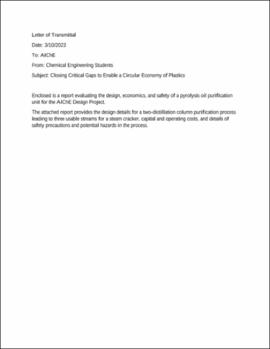| dc.contributor.author | McIntosh, Riley | |
| dc.contributor.author | Almutairi, Woroud | |
| dc.contributor.author | Bias, Alex | |
| dc.contributor.author | Ecklund, Elijah | |
| dc.date.accessioned | 2023-05-12T21:38:09Z | |
| dc.date.available | 2023-05-12T21:38:09Z | |
| dc.date.issued | 4/28/2023 | |
| dc.identifier | oksd_mcintosh_aiche_design_project_spring_2023 | |
| dc.identifier.uri | https://hdl.handle.net/11244/337667 | |
| dc.description.abstract | The purpose of this project is to have an efficient and cost-effective method of eliminating plastic waste. One of these methods is turning the plastic waste into ethylene. By pyrolyzing the plastic and purifying the resulting oil, the plastic waste can then become usable in an ethylene plant. The focus of this report was to create a purification unit for the pyrolysis oil and improving the quality, quantity, and affordability of the plastic waste supplied to the pyrolyzer. | |
| dc.description.abstract | The total capital costs for the process designed were found to be $186,000,000 with 97% of the cost coming from the tanks which were sized to hold a week's worth of each product stream. The variable operation costs are $8,906,000 and the fixed operating costs are $28,870,000. The process also spares pumps to ensure that minor maintenance and necessary repairs on these inexpensive parts does not necessitate a process shut down and the loss of productivity. | |
| dc.description.abstract | The feed of pyrolysis oil is supplied at 100°F and 52,430 lb/hr. Along with this, the oil is considered to be complex with a wide boiling mixture of molecules. It is fractionated through two distillation columns into Pygas, Pyoil light cut, Pyoil medium cut, and Pyoil heavy cut. If water entered the oil, a process was implemented to eliminate it. Water was found to be all vaporized in the first column and combined with the Pygas, therefore, Pygas itself has to be dehydrated in an adsorber and then sent immediately as feed for the ethylene plant. It was found that the Pygas, after dehydration had a flow rate of 2,486 lb/hr. The Pyoil light cut and Pyoil medium cut have fears of contamination of salts and heavy metals, which a steam cracker can't handle. In order to ensure the safety of equipment, the light and medium cuts need to be sent through adsorbers to remove metals and chlorides and then stored in tanks for use as fuel in the steam cracker. It was found that the light cut's flow rate is 1,199 lb/hr and the medium's flow rate as 35,000 lb/hr. The Pyoil heavy cut is unsuitable for use in the steam cracker and is held in a tank to await waste treatment. | |
| dc.description.abstract | The process is designed with inherent safety in mind, using a two-column design to improve inherent safety and taking into account the effects of corrosion from water and chlorides in selecting materials of construction. Controls primarily focused on temperature, pressure, and level in the two distillation columns to ensure quality and safety of the process. To account for the possibility of an overpressure event, a pressure relief system using a rupture disk upstream of a pressure relief valve to vent gases to a flare is sized for the worst-case scenario of a fire in the column. Waste liquids collected by a knockout drum for this pressure relief system are sent to a process sewer assumed to be on site and compatible with the materials in this purification process. | |
| dc.description.abstract | The quality, quantity, and affordability of the plastic supply from the Bali Sorting Facility is suggested to be improved by focusing on opportunities for recycling afforded by the large tourist industry by pushing tourist buy-in. Additionally, by moving beyond households to small businesses and corporations, larger quantities of plastic could be obtained with less travel time, reducing overall costs. | |
| dc.format | application/pdf | |
| dc.language | en_US | |
| dc.rights | Copyright is held by the author who has granted the Oklahoma State University Library the non-exclusive right to share this material in its institutional repository. Contact Digital Library Services at lib-dls@okstate.edu or 405-744-9161 for the permission policy on the use, reproduction or distribution of this material. | |
| dc.title | AIChE Design Project Spring 2023: Closing critical gaps to enable a circular economy of plastics | |
| osu.filename | oksd_mcintosh_aiche_design_project_spring_2023.pdf | |
| osu.accesstype | Open Access | |
| dc.type.genre | Honors Thesis | |
| dc.type.material | Text | |
| thesis.degree.discipline | Chemical Engineering | |
| thesis.degree.grantor | Oklahoma State University | |
